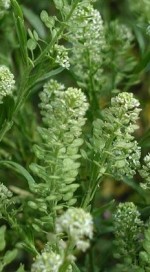 Peppercorn is an annual native to North American and found all over the United States including Alaska and Hawaii. A relative of the mustard family it is related to broccoli, cauliflower, cabbage, and turnips as well as stock and purple rock cress (Aubrieta deltoidea). It prefers a medium to dry site with full sun but tolerates half day of shade. Pepperweed commonly grows in gardens, lawns, cropland, and waste areas such as roadsides. The plant is edible and has a peppery taste.
Peppercorn is an annual native to North American and found all over the United States including Alaska and Hawaii. A relative of the mustard family it is related to broccoli, cauliflower, cabbage, and turnips as well as stock and purple rock cress (Aubrieta deltoidea). It prefers a medium to dry site with full sun but tolerates half day of shade. Pepperweed commonly grows in gardens, lawns, cropland, and waste areas such as roadsides. The plant is edible and has a peppery taste.
 Description: In mild climates pepperweed appears in fall as a basal rosette of leaves that overwinters but in areas with severe winters it does not appear until spring. The rosette is composed of hairless pinnately lobed leaves that are oval in outline. In mid-spring the rosette sends up an erect flowering stem that is highly branched and grows up to 20” high. The rosette usually dies once the stem is produced. The leaves on the stem are linear, alternate, not lobed, and lack petioles. During the summer clusters of small flowers with four white or greenish petals are produced in dense racemes at the ends of the branches giving the appearance of bottle brushes. The small fruits are round, flattened and winged, and contain two seeds. A slender taproot anchors the plant.
Description: In mild climates pepperweed appears in fall as a basal rosette of leaves that overwinters but in areas with severe winters it does not appear until spring. The rosette is composed of hairless pinnately lobed leaves that are oval in outline. In mid-spring the rosette sends up an erect flowering stem that is highly branched and grows up to 20” high. The rosette usually dies once the stem is produced. The leaves on the stem are linear, alternate, not lobed, and lack petioles. During the summer clusters of small flowers with four white or greenish petals are produced in dense racemes at the ends of the branches giving the appearance of bottle brushes. The small fruits are round, flattened and winged, and contain two seeds. A slender taproot anchors the plant.

 Control: Hand pulling or mowing the plants before they produce seed offers good control. Preemergent herbicides such as isoxaben, and post emergent herbicides such as 2,4-D, dicamba, MCPP, and MCPA, are effective for heavy infestations.
Control: Hand pulling or mowing the plants before they produce seed offers good control. Preemergent herbicides such as isoxaben, and post emergent herbicides such as 2,4-D, dicamba, MCPP, and MCPA, are effective for heavy infestations.